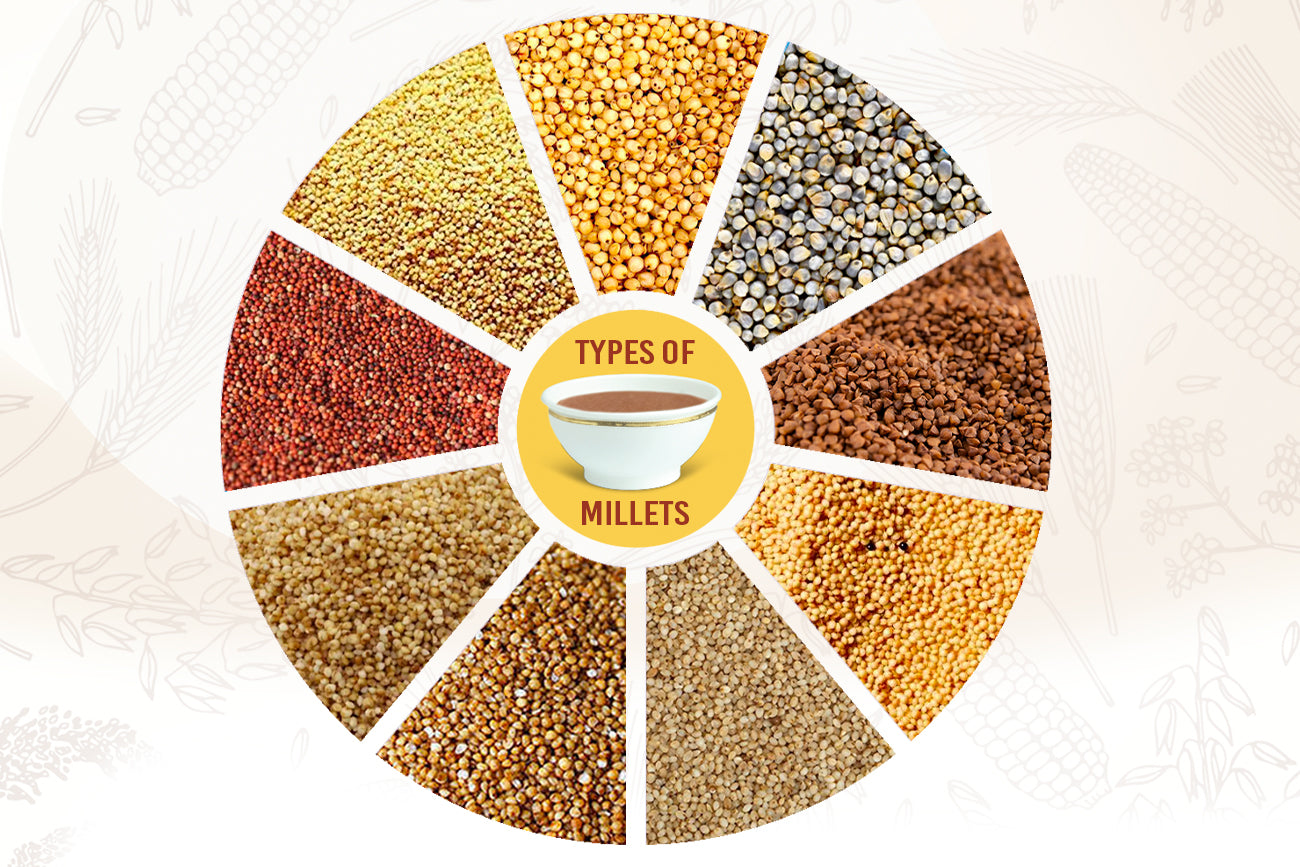

Exploring Different Types of Millets: Your Guide to Healthy Grains
Millets are ancient grains that are gaining popularity as a healthy alternative to rice and wheat. They are gluten-free, low in glycemic index, and packed with nutrients. Millets have been an essential part of Indian cuisine and agriculture for thousands of years. In recent times, they have been gaining popularity as a superfood due to their numerous health benefits.
In this article, we will explore the different types of millets available and their uses. We will also discuss the health benefits of millets and their significance in Indian cuisine and agriculture.
Key Takeaways
- Millets are ancient grains that are gaining popularity as a healthy alternative to rice and wheat.
- Millets are gluten-free, low in glycemic index, and packed with nutrients.
- Millets have been an essential part of Indian cuisine and agriculture for thousands of years.
Health Benefits of Millets
Millets are not only delicious, but they also offer a wide range of health benefits. Here are some of the top reasons why you should consider incorporating millets into your diet:
Rich in Nutrients
Millets are packed with essential nutrients that are important for maintaining good health. They are rich in fiber, protein, and essential amino acids, making them a great addition to any diet. Millets are also a good source of vitamins and minerals like iron, magnesium, and phosphorus, which are all important for maintaining healthy bodily functions.
Great for Digestion
Millets are easy to digest and can help prevent digestive problems like constipation. They are also a great source of prebiotics, which can help improve gut health and boost the immune system. Millets are also gluten-free, making them a great option for those with celiac disease or gluten intolerance.
Can Help Manage Diabetes
Millets have a low glycemic index, which means that they can help regulate blood sugar levels and prevent spikes in insulin. This makes them a great option for those who are trying to manage their blood sugar levels. Millets are also high in fiber, which can help slow down the absorption of glucose into the bloodstream.
Can Help with Weight Loss
Millets are low in calories and high in fiber, which can help keep you feeling full for longer periods of time. This can help reduce overall calorie intake and promote weight loss. Millets are also a great source of protein, which can help boost metabolism and burn calories more efficiently.
Incorporating millets into your diet is a great way to improve your overall health and wellbeing. Not only are they delicious, but they also offer a wide range of health benefits. So why not give them a try?
Different Types of Millets and Their Uses
Millets are a great addition to your diet if you are looking to lose weight or manage diabetes. Their high fiber content helps you feel full for longer, preventing unnecessary snacking and aiding weight loss. Additionally, their low glycemic index ensures that they do not cause spikes in blood sugar levels, making them a great choice for people with diabetes. And best of all, millets are incredibly versatile and can be used in a wide range of recipes!
Millets for Weight Loss
If you are aiming to shed some extra weight, millets can be a great addition to your diet. They are rich in fiber, which helps keep you feeling satiated for longer periods, reducing the likelihood of overeating or snacking on unhealthy foods. Millets also have a low glycemic index, making them an ideal food choice for weight loss. The fiber content in millets also makes them great for digestion, improving gut health and overall well-being.
Some great millets to include in your diet for weight loss include foxtail millet, little millet, and kodo millet. These millets can be used to make a variety of dishes, such as millet upma or millet dosa. By replacing rice or wheat with millets in your meals, you can easily make your diet healthier and more weight-loss-friendly.
Millets for Diabetes
Millets are also a great food option for people with diabetes. Their low glycemic index ensures that they do not cause spikes in blood sugar levels, making them safe for people with diabetes to consume. Millets are also rich in fiber, which helps regulate blood sugar levels and prevent sudden spikes.
Some great millets for people with diabetes include finger millet, pearl millet, and sorghum. These millets can be used to make a range of diabetic-friendly dishes, such as millet upma and bajra khichdi.
Millets Recipes
Millets are incredibly versatile and can be used in a wide range of recipes. From breakfast to dinner, there is a millet dish for every meal! Some popular millet dishes include:
- Millet khichdi: a savory preparation made with millets, lentils, and vegetables
- Millet dosa: a healthy and delicious alternative to regular dosa
- Millet upma: a filling and nutritious breakfast dish
- Millet porridge: a comforting and wholesome breakfast option
Experiment with different millets and recipes to find what works best for you. With their versatility and health benefits, millets are a great addition to any diet!
Millets in Agriculture and Indian Cuisine
Millets have been a staple food in India for centuries. These hardy crops are drought-resistant, require minimal water and fertilizers, and can grow in poor soil conditions, making them an ideal crop for small-scale farmers and those living in arid areas. India is the largest producer of millets in the world, with over 8 million hectares of land devoted to their cultivation.
In addition to being a valuable source of food, millets also have several environmental benefits. They can be grown in rotation with other crops, improving soil fertility and reducing the risk of pests and diseases. Millet cultivation also helps to conserve water and biodiversity, making it an eco-friendly choice for farmers.
Millets in Indian Cuisine
Millets have been a part of Indian cuisine for centuries. In many regions, they are used to make traditional dishes like roti, dosa, idli, and upma. Millets are also used to make porridges, soups, and stews. With their mild, nutty flavor, millets can be used in place of rice or quinoa in many dishes.
One popular millet dish is ragi mudde, a ball of finger millet that is served with a spicy curry or soup. Another traditional dish is kambu koozh, a porridge made with pearl millet that is popular in southern India. Millets can also be used to make desserts, like millet pudding or laddoo.
Millets for Weight Loss and Diabetes
Millets are a great choice for those looking to lose weight or manage diabetes. These grains are low in glycemic index, meaning they release sugar slowly into the bloodstream, keeping your blood sugar levels steady. They are also high in fiber, which helps to keep you feeling full for longer and aids in digestion.
Studies have shown that millets can help to reduce the risk of type 2 diabetes and improve insulin sensitivity in those who already have the condition. Millets are also a good source of protein, vitamins, and minerals, making them a nutritious addition to any diet.
Millets Recipes
There are many delicious millet recipes that you can try at home. For a quick and easy breakfast, try making millet porridge with almond milk, cinnamon, and honey. You can also use millets to make a healthy and filling salad with roasted vegetables and feta cheese.
If you're in the mood for something more substantial, why not try making a millet and vegetable stir-fry? Simply sauté some onions, peppers, and broccoli, then add cooked millet and a few spoonfuls of soy sauce. For a tasty snack, try making millet and nut energy bars with dates, nuts, and seeds.
| Millets | Uses |
|---|---|
| Finger millet | Porridge, roti, idli, koozh |
| Pearl millet | Porridge, bread, upma, stews |
| Sorghum | Roti, porridge, popped as a snack |
| Little millet | Upma, porridge, kheer |
| Barnyard millet | Porridge, upma, khichdi |
With so many different types of millets and countless ways to prepare them, there's sure to be a recipe that you'll love.
Conclusion
In conclusion, millets are a nutritious and healthy alternative to rice and wheat. They come in various types and offer a plethora of health benefits. Millets are a great source of protein, fiber, and essential minerals. They help in weight management and diabetes control. Furthermore, millets are an integral part of Indian cuisine and farming practices. They are versatile and can be used in various recipes and dishes. Incorporating millets into your diet can help improve your overall health and well-being. So, next time you're grocery shopping, pick up a pack of millets, and explore the different types of millets and their uses. Trust us; your taste buds and body will thank you!
FAQ
Q: What are the different types of millets?
A: There are several different types of millets, including pearl millet, finger millet, foxtail millet, and barnyard millet.
Q: What are the health benefits of millets?
A: Millets are packed with nutrients and offer numerous health benefits such as improved digestion, reduced risk of heart disease, and increased energy levels.
Q: Can millets help with weight loss?
A: Yes, millets can be beneficial for weight loss as they are low in calories and high in fiber, which helps promote a feeling of fullness.
Q: Are millets suitable for individuals with diabetes?
A: Yes, millets have a low glycemic index, which means they cause a slower rise in blood sugar levels. They can be a good option for individuals with diabetes.
Q: Are there any millet recipes available?
A: Absolutely! There are plenty of millet recipes available. You can check out Naario's Instagram for such healthy and tasty food inspiration.
Q: How are millets used in Indian cuisine?
A: Millets have been a staple in Indian cuisine for centuries. They are used to make various dishes like rotis, dosas, and porridges. They add a nutty flavor and texture to traditional Indian recipes.
